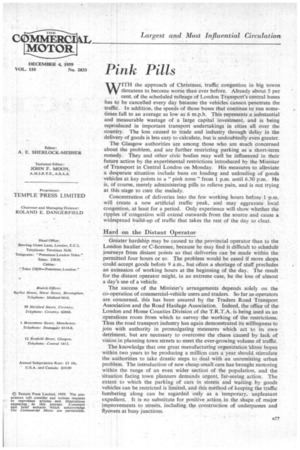Pink Pills
Page 33

If you've noticed an error in this article please click here to report it so we can fix it.
WITH the approach of Christmas, traffic congestion in big towns threatens to become worse than ever before. Already about 5 per cent, of the scheduled mileage of London Transport's central buses has to be cancelled every day because the vehicles cannot penetrate the traffic. In addition, the speeds of those buses that continue to run sometimes fall to an average as low as 6 m.p.h. This represents a substantial and measurable wastage of a large capital investment, and is being reproduced in important transport undertakings in cities all over the country. The loss caused to trade and industry through delay in the delivery of goods is less easy to calculate, but is undoubtedly even greater.
The Glasgow authorities are among those who are much concerned about the problem, and are further restricting parking as a short-term remedy. They and other civic bodies may well be influenced in their future action by the experimental restrictions introduced by the Minister of Transport in Central London on Monday. His measures to alleviate a desperate situation include bans on loading and unloading of goods vehicles at key points in a "pink zone" from 1 p.m. until 6.30 p.m. He is, of course, merely administering pills to relieve pain, and is not trying at this stage to cure the malady.
Concentration of deliveries into the few working hours before-1 p.m. will create a new artificial traffic peak, and may aggravate local congestion, at least for a period. Only experience will show whether the ripples of congestion will extend outwards from the source and cause a widespread build-up of traffic that takes the rest of the day to clear.
Hard on the Distant Operator
Greater hardship may be caused to the provincial operator than to the London haulier or C-licensee, because he may find it difficult to schedule journeys from distant points so that deliveries can be made within the permitted four hours or so. The problem would be eased if more shops could accept goods befoie 9 a.m., but .often a shortage of staff precludes an extension of working hours at the beginning of the day. The result for the distant operator might, in an extreme case, be the loss of almost a day's use of a vehicle.
The success of the Minister's arrangements depends solely on the co-operation of commercial-vehicle users and traders. So far as operators are concerned, this has been assured by the Traders Road Transport Association and the Road Haulage Association. Indeed, the office of the London and Home Counties Division of the T.R.T.A.-is being used as an operations room from which to survey the working of the restrictions. Thus the road transport industry has again demonstrated its willingness to join with authority in promulgating measures which act to its own detriment, but are necessary to overcome the chaos caused by lack of vision in planning town streets to meet the ever-growing volume of traffic.
• The knowledge that one great manufacturing organization 'alone hopes within two years to be producing a million cars a year should stimulate the authorities to take drastic steps to deal with an unremitting urban problem. The introduction of new cheap small cars has-brought motoring within the range of an even wider section of the population, and the situation facing town planners demands urgent, far-seeing action. The extent to which the parking of cars in streets and waiting by goods vehicles can be restricted is limited, and this method of keeping the traffic lumbering along can be regarded only as a temporary, unpleasant expedient. It is no substitute for positive action. lathe shape of major improvements to streets, including the construction of underpasses and flyovers at busy junctions.
























































































































